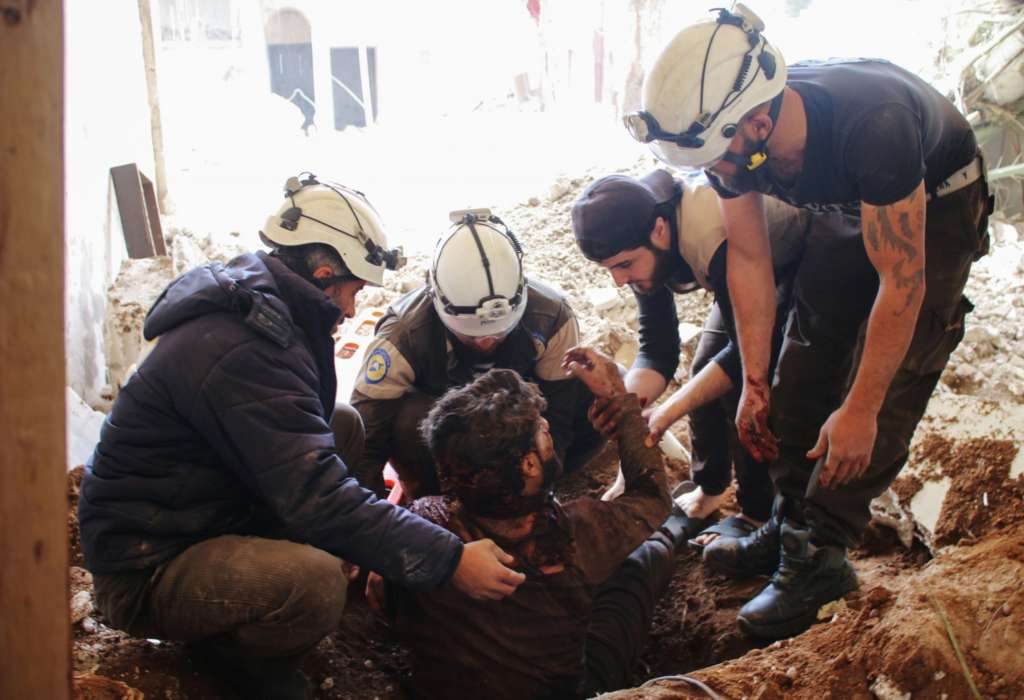Nearly a month has passed since a sarin gas attack on the Syrian village of Khan Sheikhoun prompted President Trump to bombard a regime airbase with cruise missiles. The good news since then is that there have been no further attacks on civilians using sarin — though the regime of Bashar al-Assad is believed to possess several tons more of it — or chlorine, though “barrel bombs” filled with that chemical were routinely dropped on hospitals, schools and apartment buildings before April 7.
Now for the bad news, which has been almost entirely ignored by a White House that long ago moved on to other issues: Syrian and Russian planes have been pounding civilian targets across Syria on a daily basis with bunker busters, cluster bombs, phosphorus and barrel bombs packed with shrapnel. On a typical day last week, between 70 and 80 people were killed in the civil war, according to reports from the Syrian Observatory for Human Rights — about the same number as died from the gas attack in Khan Sheikhoun.
Did Trump make Syrians any safer? “Sadly speaking, no,” says Raed al-Saleh, the head of the White Helmets civil defense organization, which told the world about the sarin attack. “They managed to stop the use of chemical weapons. But the killing still goes on with all the other kinds of weapons.”
During a visit to Washington last week, Saleh grimly described the rubble his teams have been digging through in the past several weeks. There was the Shaam Hospital, which was built into an underground cave six miles west of Khan Sheikhoun: Russian planes dropped six bunker busters on it on April 22, collapsing it and trapping doctors and patients under heavy stone. On Wednesday and Thursday, three more hospitals were bombed in the same northwestern region. In two of those cases, the planes came back to strike the White Helmets’ rescue operations.
The organization has become a prime Russian target since it provided evidence of the sarin attack, Saleh said. In the days after the US missile salvo the White Helmets’ center in Khan Sheikhoun was bombed; the staff survived in an underground shelter but all their vehicles were destroyed. Two other nearby White Helmets facilities were struck, including in Saleh’s hometown of Jisr ash-Shugur. Meanwhile Russia launched an all-out propaganda offensive: In a briefing in Moscow on Thursday, a Foreign Ministry spokeswoman accused the group of collaborating with ISIS and an al-Qaeda affiliate as well as providing “the US a pretext to carry out an act of aggression.”
In fact the White Helmets have been an island of humanity in an otherwise bleak barbarian landscape. As of last week they had counted nearly 91,000 people saved since Saleh helped to establish the group in rebel-controlled northern Syria in 2013. He says it now has 3,300 workers in 120 centers across nine Syrian provinces. One hundred eighty-four have been killed and 500 injured, including eight who died in an airstrike Saturday. Many of the casualties came in deliberate bombings of rescue operations. Yet Saleh says there is a long waiting list of volunteers ready to join when spots open up: “When we request 10 volunteers we get applications from 700.”
The rescuers are paid a monthly salary of about $150 — but their real motivation is saving their friends and neighbors. “Every time they pull a baby from the rubble they find the motivation to go on,” said Farouq Habib, an aid and training coordinator for the group. International support has been heavy: Most major Western governments have supplied funding, including more than $20 million from the Obama administration; an online campaign has attracted more than 200,000 small donors and more than $12 million in contributions.
The White Helmets have become a leading candidate for a Nobel Peace Prize. But the 34-year-old man who leads them is anything but sanguine. Wearing a black suit, black shirt and black tie with purple stripes, Saleh spoke in a funereal monotone as he described the group’s strategy for avoiding Russia’s “double-tap” strikes on rescuers: “We don’t have one. We have to be available immediately at the site. Minutes or seconds can save lives. So we don’t have the option to wait.”
When I asked Saleh how Syria’s carnage could end, he cited what he said was the only day since 2011 when no Syrians were killed: Feb. 28, 2016, when a cease-fire brokered by the United States and Russia went into effect. It soon crumbled, but Saleh says that is the only way out: “a political solution” that comes about from “serious will from the major political powers.”
In other words, a single US airstrike isn’t enough. Unless and until Trump is willing to do more, the White Helmets will still be digging though rubble.
(The Washington Post)
